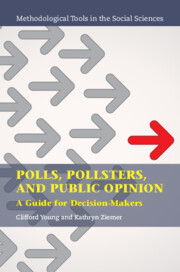Book contents
- Polls, Pollsters, and Public Opinion
- Methodological Tools in the Social Sciences
- Polls, Pollsters, and Public Opinion
- Copyright page
- Contents
- Figures
- Graphs
- Quadrants
- Tables
- Acknowledgments
- 1 The Three-Hatted Pollster
- Part I The Fundamentals of Public Opinion
- 2 What Is Public Opinion?
- 3 Attitude Formation at the Individual Level
- 4 When Public Opinion Is Stable and When It Is Not
- Part II The Pollster as Data Scientist
- Part III The Pollster as Fortune Teller
- Part IV The Pollster as Spin Doctor
- Index
4 - When Public Opinion Is Stable and When It Is Not
from Part I - The Fundamentals of Public Opinion
Published online by Cambridge University Press: 01 November 2024
- Polls, Pollsters, and Public Opinion
- Methodological Tools in the Social Sciences
- Polls, Pollsters, and Public Opinion
- Copyright page
- Contents
- Figures
- Graphs
- Quadrants
- Tables
- Acknowledgments
- 1 The Three-Hatted Pollster
- Part I The Fundamentals of Public Opinion
- 2 What Is Public Opinion?
- 3 Attitude Formation at the Individual Level
- 4 When Public Opinion Is Stable and When It Is Not
- Part II The Pollster as Data Scientist
- Part III The Pollster as Fortune Teller
- Part IV The Pollster as Spin Doctor
- Index
Summary
This chapter provides an overview of the arguments for the stability of public opinion as well as the arguments of those who believe public opinion is unstable. We then explore conditionality, or the conditions under which public opinion appears to be more unstable. Concepts such as low information rationality, issue salience, and question wording are covered.
Keywords
- Type
- Chapter
- Information
- Polls, Pollsters, and Public OpinionA Guide for Decision-Makers, pp. 38 - 50Publisher: Cambridge University PressPrint publication year: 2024

